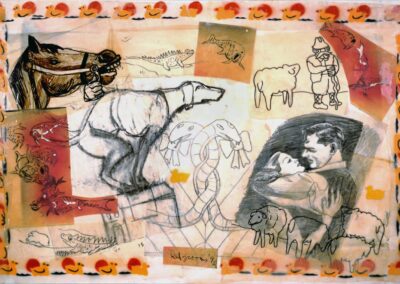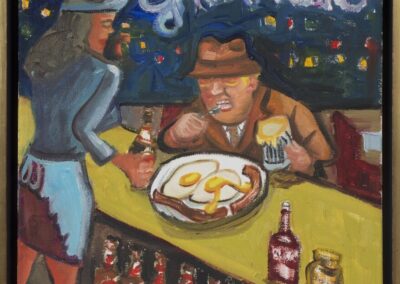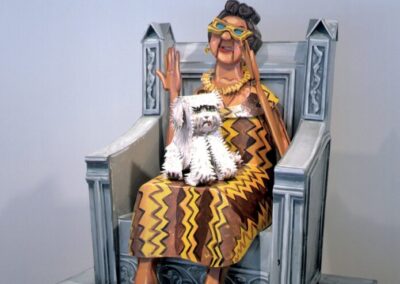Our next Artist You Need To Know is Red Grooms.
Grooms is an American artist who works in paint and a variety of other media, often creating small and large sculptures that are influenced by Pop Art, whose work have both a playful and frenetic quality that reflects contemporary urban life and the world around him. Born Charles Rogers Grooms in 1937 in Nashville, Tennessee, during the Great Depression, his nickname of ‘Red’ was bestowed on him by gallerist Dominic Falcone (of the Sun Gallery in Provincetown, Massachusetts) when Grooms was employed as a dishwasher in a Provincetown restaurant but also studying under the seminal teacher and artist Hans Hofmann.
From Artsy : “Since the 1970s, Red Grooms has used cartoonish imagery to satirize city life, most notably in crowd-pleasing, large-scale sculptures and public installations. He found acclaim in 1975 with Ruckus Manhattan, a caricatured, three-dimensional recreation of New York City. The interactive installation features iconic landmarks populated by life-sized wooden figures of sex workers, thieves, gamblers, tourists, shoppers, and families who altogether suggest the city’s grit and glamour. Grooms has also channeled his signature sense of satire, kitsch, and Americana into mixed-media paintings, drawings, prints, and performances.”
The art critic G. R. Swenson (one of the most prolific supporters of Pop Art during his life) spoke of Grooms as being a fine example of an artistic movement and generation who “took the world too seriously not to be amused by it.”
Grooms began his studies at the Art Institute of Chicago and could continue them at Nashville’s Peabody College. He moved to New York City in 1956 to attend the New School for Social Research, and a year later he attended a summer session at the Hans Hofmann School of Fine Arts in Provincetown, Massachusetts. This was a defining moment in Grooms’ career. At the time, he was more focused on set design (something that can be seen in his sculptural works throughout his career) but his primary focus became fine art during his time at the Hofmann School. Another important influence at this time was the experimental animation pioneer Yvonne Andersen : they would collaborate on several short films, and the expressive, cinematic quality of many of Grooms’ artworks manifest an interest in the vitality of film and animation.
Historian and cultural critic Judith Stein offers that “At times Grooms’s humor has an absurdist streak, full of the impetuous energy and preposterous puns of the Marx Brothers. He shares a comic sense with Bob and Ray whose straight-man/funny-man teamwork plays off against the mundane conventions of daily life. As an empiricist with a keen political sense and a retentive memory for visual facts, Grooms follows in the tradition of William Hogarth and Honoré Daumier, who were canny commentators on the human condition.”
Solo exhibitions of Grooms’ artwork have been mounted at the Whitney Museum of American Art, the Yale University Art Gallery, the Modern Art Museum of Fort Worth, and the Pennsylvania Academy of the Fine Arts, Cheekwood Botanical Garden and Museum of Art in Nashville, the Montgomery Museum of Fine Arts, the Cleveland Museum of Art, the Carnegie Museum of Art, the Tennessee State Museum and the Knoxville Museum of Art, among numerous other spaces. Grooms’ artworks can be found in the collections of the Museum of Modern Art, the Art Institute of Chicago, the Guggenheim Museum, the Hirshhorn Museum and Sculpture Garden, the Metropolitan Museum of Art, and Moderna Museet.
In 2003, the National Academy of Design recognized Grooms with a Lifetime Achievement Award. He currently lives in New York City : he works in a studio in lower Manhattan where he has been in the tumult of the city for the past four decades.
More about the life and work of Red Grooms can be enjoyed here. A short video tour of several of his more monumental sculptures (installed at the Modern Art Museum of Fort Worth) can be seen here.
The late art critic and poet Peter Schjeldahl once famously likened Red Grooms to Marcel Duchamp, because both embodied “a movement of one man that is open to everybody.”





















